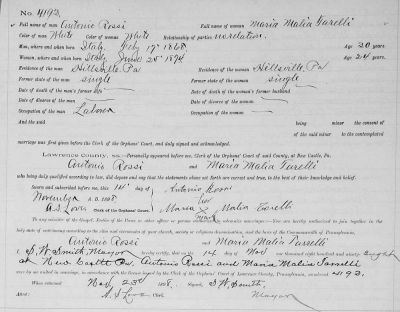When your ancestors settled in America, many of the important events that happened in their lives and their families’ lives were recorded in United States vital records. The main types of records that may yield valuable information about your ancestors are marriage, birth and death records. Each of these types of records has a distinct advantage in discovering or adding details to your family history. It is also beneficial to know when vital records were routinely created and where to look for them. Like other types of records, finding your Italian ancestors’ records are sometimes challenging, so we are going to look at those challenges and how to overcome them. Our focus this month is on marriage records.
Marriage records are some of the oldest life events recorded and preserved. For our immigrant ancestors, if they married in the U.S., you will likely be able to find their record if you know where and how to look for it. The two biggest challenges to locating a marriage record in America are knowing where to look and knowing “who” to look for.
Where to Look:
In Italy, church weddings were the norm, but in America, a marriage performed by a Justice of the Peace was very common for our immigrant ancestors. Therefore, I recommend starting your search for a civil record in the town or county in which the couple resided or where the bride resided before marriage. Sometimes you may need to search in an adjoining town or county if you find no record where you expected to find one. For example, in my experience where my community is located on the Ohio and Pennsylvania border, often I find myself searching for records across the state line as it was common for immigrants to move between the two states.
Even when a church ceremony was performed, a civil record of the event was required to be recorded. The town clerk or county register kept early marriage records. Fortunately, these records are usually arranged by year with a handy surname index for both the groom and the bride. To start your search, you will need to know the approximate year. If you do not know an exact date, start with two years prior to the birth of the couple’s first child or look at the 1900 or 1910 Census which had a question for the number of years married which will help you on the date. Many marriage records can be found online at www.familysearch.org (free) or at www.ancestry.com (subscription or at a library). If the records for a particular town or county are not online, then you will need to contact the local clerk for information on where records are kept and how to obtain them. I use Google to search for the contact information for the clerk’s office information in a particular locality.
Who to Look For:
Particularly for Italians, we often find surname misspellings in marriage records due to the language barrier and inability to read or write on the part of our ancestors. When searching for your ancestor’s name in an index, look for both the groom and the bride. Their name may have been spelled phonetically in the records, so a trick I use is to say the surname aloud with an Italian accent and try to imagine how it would have sounded to an American. I have sometimes resorted to going through record by record in the record book for a particular year in case, for some reason, the marriage record was not indexed properly. Patience and creativity is the key to finding records where there was a surname anomaly.
What You Will Find:
Information that may be found in a marriage record is age at time of marriage, original names and birthplace of the couple, their occupations, and whether they were ever previously married. Even if your ancestors were married in Italy, the marriage records of their children may be particularly valuable if you do not know the name of a female ancestor. I have used marriage records for American-born children to find the surname of a child’s mother when there was no other record to be found. This is why it is always good to start searching here in America for all available records before attempting to search across the ocean.
Next month we will look at death records, which also yield valuable information for your family history.
Chart
Typical Genealogical Information Found in Marriage Records
- Full Names of Groom and Bride
- Places of birth
- Occupations
- Residence
- Date of Marriage
- Whether Previously Married
- Where the marriage took place
- Who performed the marriage
- Names of witnesses
- Parent’s names



